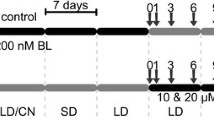Abstract
We recently demonstrated the biosynthesis of 24-ethylidene brassinosteroids in Arabidopsis thaliana. To determine the physiological role of biosynthesis of 24-ethylidene brassinosteroids, metabolism of 28-homodolichosterone as the end product of 24-ethylidene brassinosteroids biosynthesis was examined by a crude enzyme solution prepared from A. thaliana. In wild-type plants, dolichosterone and castasterone were identified as enzyme products on GC-MS analysis. In a mutant where DWARF1 was overexpressed (35S-DWF1), the conversion rate of 28-homodolichosterone to castasterone was significantly increased. These results indicate that conversion of 28-homodolichosterone to castasterone is mediated by dolichosterone in Arabidopsis. In the root growth assay, inhibitory activity was enhanced in the order of castasterone > dolichosterone > 28-homodolichosterone, demonstrating that conversion of 28-homodolichosterone to castasterone via dolichosterone is a biosynthetic reaction that increases BR activity in Arabidopsis. Compared to Arabidopsis grown under dark conditions, light-grown Arabidopsis showed up-regulated DWARF1 expression, resulting in an increased conversion rate of 28-homodolichosterone to castasterone, suggesting that light is an important regulatory factor for the biosynthetic connection of 24-ethylidene brassinosteroids and 24-methyl brassinosteroids in A. thaliana. Consequently, 24-ethylidene brassinosteroids biosynthesis to generate 28-homodolichosterone is a lightregulated alternative route for synthesis of the biologically-active BRs, castasterone and brassinolide in Arabidopsis plants.
Similar content being viewed by others
References
Chung HY, Fujioka S, Choe S, Lee S, Lee YH, Baek NI, Chung IS (2010) Simultaneous suppression of three genes related to brassinosteroid (BR) biosynthesis altered campesterol and BR contents, and led to a dwarf phenotype in Arabidopsis thaliana. Plant Cell Rep 29:397–402
Joo SH, Jang MS, Kim MK, Lee JE, Kim SK (2015) Biosynthetic relationship between C28-brassinosteroids and C29-brassinosteroids in rice (Oryza sativa) seedlings. Phytochemistry 111:84–90
Joo SH, Kim TW, Son SH, Lee WS, Yokota T, Kim SK (2012) Biosynthesis of a cholesterol-derived brassinosteroid, 28-norcastasterone, in Arabidopsis thaliana. J Exp Bot 63:1823–1833
Kim TW, Chang SC, Choo J, Watanabe T, Takatsuto S, Yokota T, Lee JS, Kim SY, Kim SK (2000) Brassinolide and [26, 28-2H6] brassinolide are differently demethylated by loss of C-26 and C-28, respectively, in Marchantia polymorpha. Plant Cell Physiol 41:1171–1174
Kim TW, Chang SC, Lee JS, Takatsuto S, Yokota T, Kim SK (2004) Novel biosynthetic pathway of castasterone from cholesterol in tomato. Plant Physiol 135:1231–1242
Kim TW, Hwang JY, Kim YS, Joo SH, Chang SC, Lee JS, Takatsuto S, Kim SK (2005) Arabidopsis CYP85A2, a cytochrome P450, mediates the Baeyer-Villiger oxidation of castasterone to brassinolide in brassinosteroid biosynthesis. Plant Cell 17:2397–2412
Kim TW, Wang ZY (2010) Brassinosteroid signal transduction from receptor kinases to transcription factors. Annu Rev Plant Biol 61:681–704
Nolan T, Chen J, Yin Y (2017) Cross-talk of Brassinosteroid signaling in controlling growth and stress responses. Biochem J 474:2641–2661
Ryu H, Cho YG (2015) Plant hormones in salt stress tolerance. J Plant Biol 58:147–155
Turk EM, Fujioka S, Seto H, Shimada Y, Takatsuto S, Yoshida S, Denzel MA, Torres QI, Neff MM (2003) CYP72B1 inactivates brassinosteroid hormones: an intersection between photomorphogenesis and plant steroid signal transduction. Plant Physiol 133:1643–1653
Uesusuki S, Watanabe B, Yamamoto S, Otsuki J, Nakagawa Y, Miyagawa H (2004) Synthesis of brassinosteroids of varying acyl side chains and evaluation of their brassinolide-like activity. Biosci Biotechnol Biochem 68:1097–1105
Wei Z, Li J (2016) Brassinosteroids regulate root growth, development, and symbiosis. Mol Plant 9:86–100
Youn JH, Kim TW, Joo SH, Son SH, Roh J, Kim S, Kim TW, Kim SK (2018) Function and molecular regulation of DWARF1 as a C-24 reductase in brassinosteroid biosynthesis in Arabidopsis. J Exp Bot 69:1873–1886
Author information
Authors and Affiliations
Corresponding author
Rights and permissions
About this article
Cite this article
Kim, S., Moon, J., Roh, J. et al. Castasterone Can be Biosynthesized from 28-homodolichosterone in Arabidopsis thaliana. J. Plant Biol. 61, 330–335 (2018). https://doi.org/10.1007/s12374-018-0194-4
Received:
Accepted:
Published:
Issue Date:
DOI: https://doi.org/10.1007/s12374-018-0194-4




